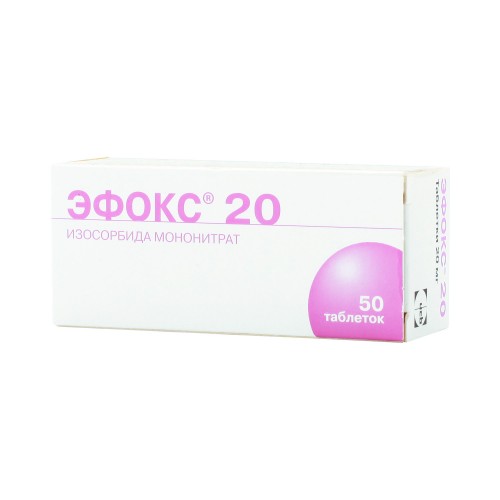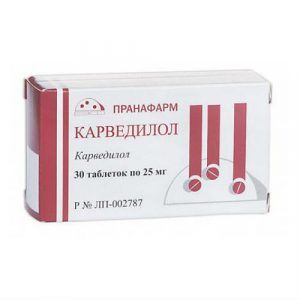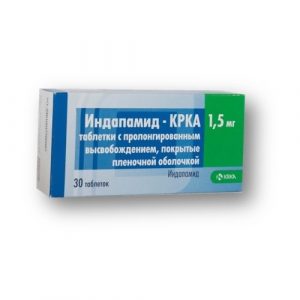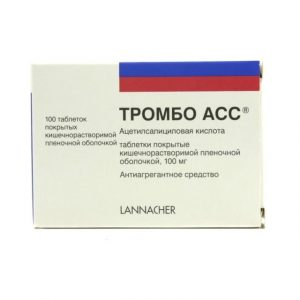Description
Latin name
EFFOX ® 20
Release form
Tablets.
Packing
50 pcs
Pharmacological action
Pharmacodynamics
Antianginal drug, organic nitrate. Peripheral vasodilator with a primary effect on venous vessels.
Stimulates the formation of nitric oxide (endothelial relaxing factor) in the vascular endothelium, causing activation of intracellular guanylate cyclase, resulting in an increase in cGMP (vasodilation mediator).
Reduces myocardial oxygen demand by reducing preload and afterload (reduces the final diastolic volume of the left ventricle and reduces the systolic tension of its walls). It has a coronary expansion effect.
Reduces blood flow to the right atrium, helps to reduce pressure in the pulmonary circulation and regression of symptoms in pulmonary edema. Promotes redistribution of coronary blood flow in the area with reduced blood circulation.
Increases exercise tolerance in patients with coronary artery disease, angina pectoris.
Expands the vessels of the brain, the dura mater, which may be accompanied by a headache.
As with other nitrates, cross tolerance develops. After cancellation (interruption of treatment), sensitivity to it is quickly restored.
The antianginal effect occurs 30-45 minutes after oral administration and lasts up to 8-10 hours.
Pharmacokinetics
Absorption
After oral administration of isosorbide, mononitrate is rapidly and completely absorbed from the gastrointestinal tract. Bioavailability is 90-100%. Cmax is reached after 30 minutes and is 100 ng / ml.
Distribution of
Binding to plasma proteins – less than 4%.
Metabolism
Isosorbide mononitrate is almost completely metabolized in the liver to form pharmacologically inactive metabolites.
Excretion of
T1 / 2 is about 4-5 hours. It is excreted by the kidneys almost exclusively in the form of metabolites, 2% – unchanged.
Indications
Prevention of angina attacks in patients with coronary artery disease, including after myocardial infarction.
Chronic heart failure (as part of combination therapy).
Contraindications
Hypersensitivity to the drug, organic nitrates.
acute circulatory disorders (shock, vascular collapse)
cardiogenic shock, if it is not possible to correct the final diastolic pressure of the left ventricle using intra-aortic counterpulsation or by administering drugs that have a positive inotropic effect
severe arterial hypotension (systolic blood pressure <90 mmHg and diastolic blood pressure <60 mmHg, central venous pressure below 4-5 mm Hg), hypovolemia, concomitant use of phosphodiesterase inhibitors, including sildenafil, vardenafil, tadalafil, since they potentiate the hypotensive effect of the drug acute myocardial infarction with severe arterial hypotension anemia (severe form) hereditary galactose intolerance, lactase deficiency or glucose and galactose malabsorption syndrome toxic pulmonary edema lactation (breastfeeding) children and adolescents under 18 years of age (efficacy and safety not established). With caution, the drug should be used in case of: hypertrophic obstructive cardiomyopathy, constrictive pericarditis, tamponade of the pericardium, decreased pressure of filling the left ventricle, for example, with acute myocardial infarction (risk of lowering blood pressure and tachycardia, which may increase ischemia), decreased left ventricular function (left ventricular). A decrease in systolic blood pressure <90 mm Hg should not be allowed. aortic and / or mitral stenosis, tendency to hypotension (orthostatic circulatory dysregulation) heart failure with low left ventricular filling pressure glaucoma (risk of increased intraocular pressure) diseases accompanied by an increase in intracranial pressure (previously an increase in pressure was noted only with iv high doses nitroglycerin), including with hemorrhagic stroke, recent head injury of severe anemia, severe renal failure of liver failure (risk of methemoglobinemia). Use during pregnancy and lactation During pregnancy and during breastfeeding, the drug should be used with extreme caution, only after a thorough assessment of the benefits and possible risks, since there is insufficient experience with its use during these periods. In experimental animal studies, no harmful effects on the fetus have been identified. Composition 1 tablet contains: Active substances: isosorbide mononitrate 20 mg. Excipients: lactose monohydrate 151.7 mg, talc 7 mg, colloidal silicon dioxide 3.5 mg, potato starch 27 mg, microcrystalline cellulose 33 mg, aluminum stearate 2.8 mg. Dosage and administration of The dose and frequency of administration are determined individually depending on the severity of the disease. It is advisable to start therapy with small doses of the drug: 10 mg 2 times / day. Then gradually increase the dose to therapeutic – 20-40 mg in 1-2 doses. If necessary, increase the dose to 60 mg / day. The maximum daily dose is 80 mg. Duration of treatment and repeated courses – on the recommendation of a doctor. Tablets should be taken orally after a meal, swallowed whole, not chewed and washed down with a small amount of liquid. Side effects From the cardiovascular system: at the beginning of treatment, a headache (nitrate headache) may occur, which, as a rule, dizziness, hyperemia of the skin of the face, sensation of heat, tachycardia decreases after a few days of therapy. Sometimes, at the first dose or after increasing the dose, a decrease in blood pressure and / or orthostatic hypotension is observed, which may be accompanied by a reflex increase in heart rate, lethargy, as well as dizziness and a feeling of weakness. In rare cases – increased angina attacks (paradoxical reaction to nitrates), orthostatic collapse. There have been cases of collaptoid states, sometimes with bradyarrhythmia and fainting. The use of the drug Efox 20 can lead to transient hypoxemia due to the relative redistribution of blood flow in hypoventilated alveolar segments. This may be the trigger of ischemia in coronary artery disease. From the digestive system: nausea, vomiting, there may be a sensation of a light burning sensation of the tongue, dry mouth. From the side of the central nervous system: stiffness, drowsiness, blurred vision, decreased ability to quickly psychic and motor reactions (especially at the beginning of treatment) rarely – cerebral ischemia. Allergic reactions: skin rash. Dermatological reactions: in some cases – exfoliative dermatitis (severe cases of multiforme exudative erythema, common impetigo and toxicoderma). Others: development of tolerance (including cross-tolerance to other nitrates). To prevent the development of tolerance, continuous use of high doses of the drug should be avoided. Lekarstvennoe Interaction Perhaps Gain hypotensive the effect with simultaneous standard receiving with the second sosudorasshyryayuschymy funds, antihypertensive funds, beta-blockers, blockers medlenn h kaltsyev h channels, diuretics, ACE inhibitors, antipsychotic assets (neuroleptics) and tricyclic antidepressants, novokaynamydom, ethanol, inhibitors fosfodyÑsteraz ( including sildenafil, vardenafil, tadalafil). Concomitant administration of isosorbide mononitrate with dihydroergotamine can increase the concentration of dihydroergotamine in blood plasma and thus enhance its antihypertensive effect. When combined with amiodarone, propranolol, slow calcium channel blockers (verapamil, nifedipine), an anti-anginal effect may be enhanced. Under the influence of beta-adrenomimetics, alpha-blockers (dihydroergotamine) it is possible to reduce the severity of the anti-anginal effect (tachycardia, excessive reduction of blood pressure). Barbiturates accelerate metabolism and reduce the concentration of isosorbide mononitrate in the blood. Reduces the effect of vasopressors. When combined with m-cholin blockers (atropine), the likelihood of increased intraocular pressure increases. Adsorbents, binders and envelopes reduce the absorption of isosorbide mononitrate in the gastrointestinal tract. The therapeutic effect of norepinephrine (norepinephrine) is reduced when co-administered with nitro compounds. It should be borne in mind that the drug interactions described above are possible even if these drugs were used shortly before Efox 20 was started. Overdose Symptoms: d then, if necessary, repeated injections of 2 mg / kg body weight with an interval between injections of 1 h are possible. 4. Oxygen therapy, hemodialysis, exchange transfusion. Storage conditions Keep out of the reach of children at a temperature not exceeding 25 ° C. Expiration 5 years. The active substance Isosorbide mononitrate Formulation Dosage form tablets




